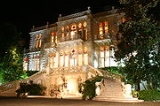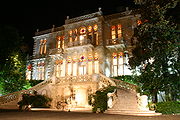
Sursock Museum
Encyclopedia

.jpg)
Museum
A museum is an institution that cares for a collection of artifacts and other objects of scientific, artistic, cultural, or historical importance and makes them available for public viewing through exhibits that may be permanent or temporary. Most large museums are located in major cities...
in Beirut
Beirut
Beirut is the capital and largest city of Lebanon, with a population ranging from 1 million to more than 2 million . Located on a peninsula at the midpoint of Lebanon's Mediterranean coastline, it serves as the country's largest and main seaport, and also forms the Beirut Metropolitan...
, Lebanon
Lebanon
Lebanon , officially the Republic of LebanonRepublic of Lebanon is the most common term used by Lebanese government agencies. The term Lebanese Republic, a literal translation of the official Arabic and French names that is not used in today's world. Arabic is the most common language spoken among...
. It is located in the historic street known as Rue Sursock
Rue Sursock
Rue Sursock is a historic street in the Achrafieh district of Beirut in Lebanon. Named after one Beirut's most prominent families, the street is home to many of Beirut's beautiful historic mansions that were built in the 18th and 19th century by aristocratic families such as the Sursock and the...
in the Achrafieh
Achrafieh
Achrafieh, , is one of the oldest Christian districts of East Beirut, Lebanon.-Overview:It is located on a hill in the eastern part of Beirut alongside the shore. Achrafieh is both a residential and commercial district characterized by narrow winding streets and prestigious large apartment and...
district of Beirut. The street is home to other mansions that were built in the 18th century by Beirut's most prominent families such as the Sursocks and the Bustroses. The museum was ranked #7 of 112 things to do in Beirut by Lonely Planet travelers.
History
The Sursock Museum is a great example of Lebanese architecture, which has Italianate, specifically VenetianRepublic of Venice
The Republic of Venice or Venetian Republic was a state originating from the city of Venice in Northeastern Italy. It existed for over a millennium, from the late 7th century until 1797. It was formally known as the Most Serene Republic of Venice and is often referred to as La Serenissima, in...
, and Ottoman
Ottoman Empire
The Ottoman EmpireIt was usually referred to as the "Ottoman Empire", the "Turkish Empire", the "Ottoman Caliphate" or more commonly "Turkey" by its contemporaries...
architectural influences. The wealthy Nicolas Sursock, a member of one of Beirut's most prominent aristocratic families, built the museum as a private villa at the end of the 19th century. Nicolas Sursock
Nicolas Sursock
Nicolas Sursock was a Lebanese art collector and a prominent member of one of Beirut's aristocratic families. He is best known for bequeathing his 19th century private villa to the city of Beirut to be transformed into a museum of modern art. His villa is known today as the Nicolas Sursock...
who died in 1961 bequeathed his villa to the city of Beirut. According to his will, the villa was transformed into a museum.
The Museum opened its doors in 1961 with an exhibit of works of contemporary Lebanese artists, setting a precedent for cultural events in Beirut. Since then, more than a hundred exhibitions have been held, displaying the works of both Lebanese and international artists. In addition to modern art, the museum's permanent collection includes Japanese engravings and Islamic art.
Expansion
The new extension of the museum consists of building four new underground floors beneath the current garden at a cost of 12 million dollars (US). French architect, Jean-Michel Wilmotte, and Lebanese architect, Jacques Abou Khaled, are leading the expansion project. The expansion project would increase the museum’s surface from 2,000 square meters to 7,000 square meters, and include additional exhibition rooms, a library, a bookshop, and music room . The project is expected to be completed end of 2012.Museum collection
The museum collection consists of 5,000 pieces, such as paintings, sculpture, ceramics, glassware, and iconography, dating from the 18th, 19th, and 20th centuries. The following is a list of Lebanese and international artists whose work is in the Museum’s permanent collection:- Chafic Abboud
- Lotti Adaimi
- Anton Asfar
- Simone Baltaxé-Martayan
- Juman Beyazit
- Saloua Raouda ChoucairSaloua Raouda ChoucairSaloua Raouda Choucair, born in 1916 in Beirut, is a Lebanese painter and sculptor. She was the first abstract artist in Lebanon though she sold nothing there until 1962....
- George Cyr
- Paul Guiragossian
- Georges Guv
- John Haddian
- Zavan Haditzian
- Madi Hussein
- Halim Jurdak
- Elie Kanaan
- Anita Toutikian
- Viola Kassab
- Michel Elmir
- Levon Moumjian
- Mounir Najm
- Omar OnsiOmar OnsiOmar Onsi, 1901–1969, in Arabic , a pioneer of modern painting in Lebanon, is Lebanon's most renowned impressionist painter.Onsi was born in Beirut. His father, a general practitioner, had been one of the first Beirut Muslims to study modern Western medicine and his mother came from the prominent...
- Aref Rayess
- Nadia Saikali
- Mohamed Sakr
- Stelio Scamanga
- Juliana Seraphim
- H. Torrossian
- Sophie Yaramian
- Khalil Zgaib
- Alain Le Yaouanc
External links
- Lebanon.com, information
- Onefineart.com, informationh

